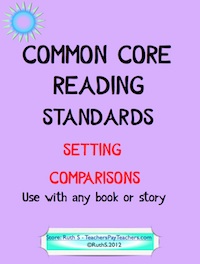When it was first announced that the Common Core Standards would be implemented in schools across the United States, I spoke to many teachers who were searching for Common Core materials. We all thought we'd be given resources that would help us "get off on a good foot" but it didn't happen.
Many teachers attended professional development workshops to prepare them for the Common Core, but no one was given specific resources they could use with their students. Everyone was scrambling for materials; no one wasn't happy.
Many teachers attended professional development workshops to prepare them for the Common Core, but no one was given specific resources they could use with their students. Everyone was scrambling for materials; no one wasn't happy.
For that reason, I designed Common Core resources that can be used with any books or stories that include "student friendly" rubrics.
Because it's very important students recognize similarities and difference of different settings, I Included five setting selections from five different books with activities designed so students could compare/contrast them.
The books' settings are on different reading levels, to accommodate a wide range of readers especially because reading groups are usually heterogeneous.
For example, it's very common to have a fifth grade ELA class with some students reading on a third, fourth, fifth, sixth and even reading on a seventh grade level!
The books' settings are on different reading levels, to accommodate a wide range of readers especially because reading groups are usually heterogeneous.
For example, it's very common to have a fifth grade ELA class with some students reading on a third, fourth, fifth, sixth and even reading on a seventh grade level!
The student friendly rubric, included, helps students understand what's expected of them in a way that's easy for them to understand.
If you like this resource, I've created others like it, that can be used with any books or stories. There's one for almost every reading strategy... theme, cause/effect, problems/solutions, main idea, character comparisons and other Common Core resources.
If you like this resource, I've created others like it, that can be used with any books or stories. There's one for almost every reading strategy... theme, cause/effect, problems/solutions, main idea, character comparisons and other Common Core resources.
Enjoy!
Ruth
You may also like...







